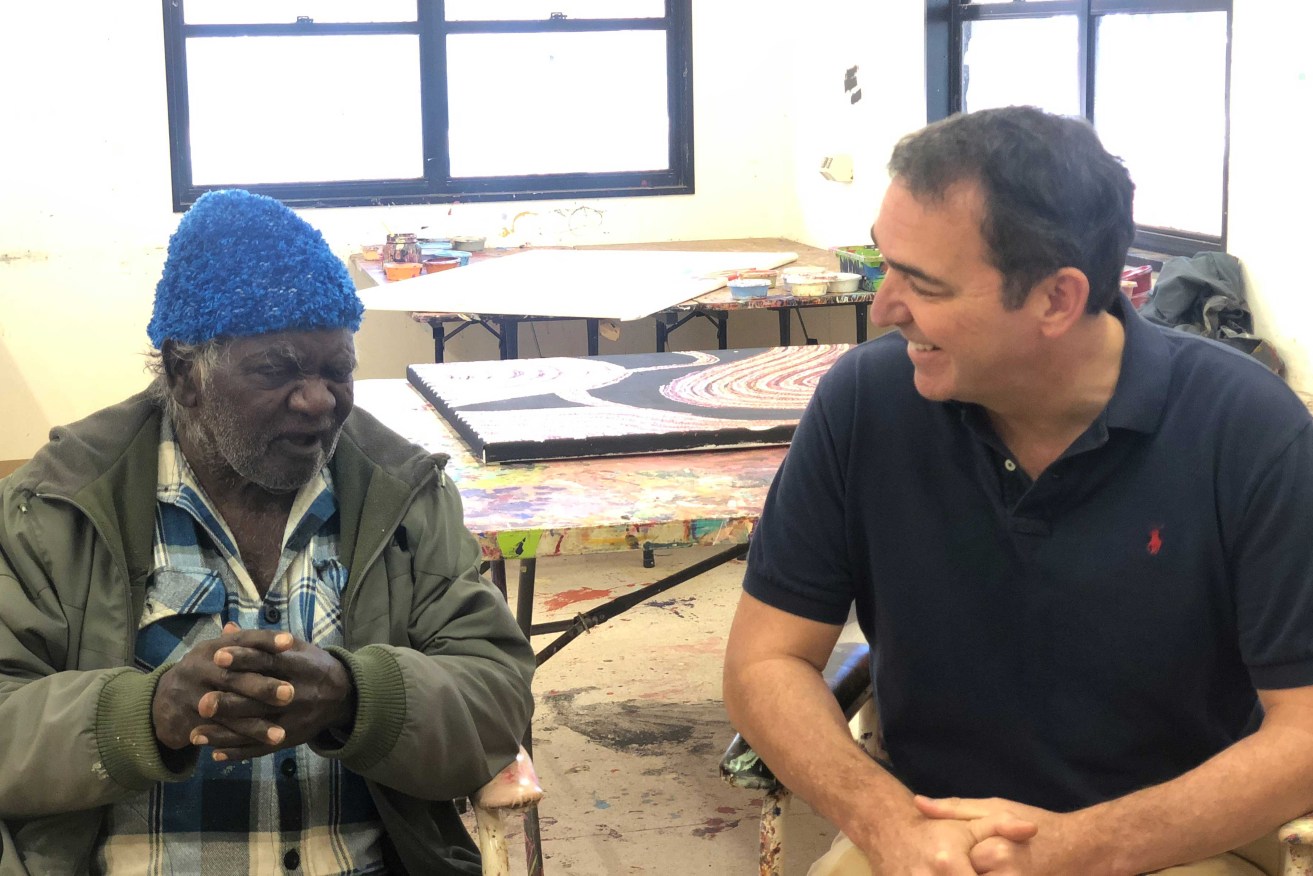Marshall’s “whole of government” approach to Aboriginal affairs
Premier Steven Marshall says he has asked his cabinet ministers to contribute to a new “whole-of-government” plan that measures South Australia’s progress on improving services to Aboriginal communities.

Premier Steven Marshall speaking to artist Pepai Jangala Caroll in Ernabella during his visit to the APY Lands. Photo: Supplied
Marshall, who returned from a three-day trip to the Anangu Pitjantjatjara Yankunytjatjara (APY) Lands last week, said the statewide plan would include “measurable” projects that could be delivered in a two-year timeframe.
He said the new plan would allow the government to better track its progress on improving services for Aboriginal communities in South Australia, rather than relying on the national Closing The Gap report for annual updates.
“One of the downsides of the annual reporting of the Closing The Gap is that it often reinforces that we’re not making much progress,” Marshall said.
“What we’ve decided to do at a state level is to have a larger number of significant steps, projects that we can actually say, yes we either achieved those or we didn’t achieve them.
“We can measure ourselves against them and demonstrate progress and momentum forward.”
Marshall, who also holds Aboriginal affairs portfolio, said before the March election that he would establish KPIs on closing the gap for all departments.
He said today that he had asked every cabinet minister and department to “think about how it can better interact with Aboriginal South Australians”.
The Government is currently drafting its first plan, which it expects to publish by the end of this year.
Marshall said employment would be a “major focus” of the first plan – an area that he said was one of the main challenges people had spoken to him about during his visit to the APY Lands.
“At the moment there are many people that just don’t have suitable or satisfying employment on the Lands and this creates a whole pile of social problems, so I think that’s one of the most important issues for this government to address,” he said.
“I spoke to the Chair of the Arts Centre at Ernabella, Elizabeth Dunn… Her major point to me – she’s an Anangu woman – was, we just need to get jobs for our young people, they’re too idle and this is causing a whole pile of problems and the number one thing we need to address is jobs for young people.
“In every community that I went to, this was an issue.”
Marshall said housing was also a major issue in remote areas.
He said the Government was working as quickly as it could to secure a new funding agreement for remote housing with the Federal Government.
Shadow Aboriginal Affairs Minister Kyam Maher had expressed concern in parliament that funding under the Federal Government’s 10-year National Partnership Agreement on Remote Housing had come to an end on June 30 this year.
Under the agreement, South Australia had received over $26 million in 2016-18 to address the housing needs of Aboriginal people in remote communities.
Marshall said he and Human Services Minister Michelle Lensink had begun negotiations with the Federal Government for renewed funding.
He said the Government had a “good working relationship” with the Federal Government, but pointed criticism to the former Labor government for not negotiating renewed funding before the March election.
“These things aren’t simple outside budget periods, but we’re hopeful of a good result, especially for the western side of the APY, far northwest. We understand that there is still further requirement in those communities.”
Lensink today said consultations would begin later this year for a new Aboriginal Housing Strategy, which she said would be led by Aboriginal people and would include service providers and the general community.
She said the Government had examined the East Kimberly Transitional Housing program as a potential model for Aboriginal housing in remote and rural South Australia.
The West Australian program aims to address the need for affordable housing in Aboriginal communities by providing transitional houses with two-year leases, which families can later choose to purchase.
Lensink said the model “aligns with South Australia’s existing Employment and Education Housing program in terms of principles and intent.”
Uniting Communities Aboriginal policy and advocacy manager Susan Tilley said the latest census of the APY lands showed there were about 75 families who were still on the waiting list for housing.
“There’s currently not enough housing stock and there’s currently a long waiting list. There’s not enough new builds and there’s also a problem maintaining stock,” she said.
Tilley said the “gains” that were made under the national partnership agreement were at risk of becoming undone if a new agreement wasn’t negotiated soon between the state and federal governments.
“It could really be quite a regressive step if they don’t maintain the funding in terms of keeping the existing housing stock up to standard.”




